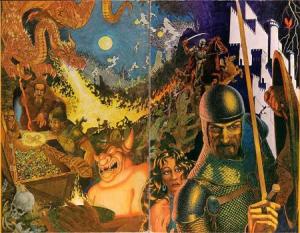In which our Hero is initiated into 1st Edition Advanced Dungeons and Dragons at the turn of the Millennium.
I’m not one of the older OSR people who can claim Grognard pedigree harking back to the Gygaxian era. My first Dungeons and Dragons game was run by Trevor, a friend of my parents. I was in my early teens and met him through dinner parties hosted by my parents, and we bonded over a shared appreciation of Warhammer Fantasy Battle and various historical/fantasy/sci-fi interests. My fledgling Orc and Goblin Waaagh, mainly cobbled together from 2nd hand purchases ad supplemented by some of Trevor’s Warhammer Quest Orc Boyz to make up the numbers, clashed against his immaculately painted Dark Elves. From a nearby shelf on the other side of the warp, similarly resplendent pre-Grimdark 2nd Ed 40K Orks brandished their kombi-weapons and watched, to the best of my recollection, their clumsily painted primitive cousins give a good accounting of themselves.
After battles Trevor would show me his other games, books and stuff. Squad Leader, Warhammer 40k, Traveller, Call of Cthulhu, old issues of White Dwarf. Advanced Dungeons and Dragons. I rolled attributes for a couple of characters before I knew anything about how the game worked. Dice rolling was 3d6 in order but I got to roll four sets and pick two. My best set had 15 in WIS and CHA so I made Hengist the half-elven Druid. The other, as far as I recall, had most stats in the 9-14 range and ended up as the adolescent half-orc fighter-thief Morglum. Along with some schoolfriends that I pulled in based on their appreciation of Warhammer and The Baldur’s Gate CRPG, I took my first tentative steps into AD&D. Our minds boggled at the huge Forgotten Realms maps, with no idea what to do with all that space. Our first encounter was with a necromancer in a graveyard, represented by a luridly painted lead lady with bared breasts and a wicked curved dagger. With a typical teenage nerd boy assertiveness with women, we bumbled until a horde of undead had risen from their graves and surrounded us before a lucky turn attempt got us out of the jam. We found a mace +1 in the crypts and were overjoyed with our precious treasure. We bought a mule and hired a small force of men at arms who all died in their first expedition (Stirge attacks in the Palace of the Silver Princess). We were lazy with mapping and got lost in dungeons, fleeing from the sound of monsters we couldn’t see and barricading ourselves inside empty rooms with iron spikes and furniture, furtively munching our iron rations and desperate to rest. We thrust a 10 foot pole into the Green Face trap from Tomb of Horrors. Our first encounter with a dragon roasted half our party (including my poor half-orc) in its first breath. We ascended the Ghost Tower of Inverness. We spent some time captured by djinni and forced to serve as gladiators in the Elemental Plane of Air. We put to rest the undead Lizard King and escaped the Hidden Shrine of Tamoachan. After a long career, Hengist, Initiate of the 9th Circle, had seen all of his earlier companions come to terrible ends in the pursuit of gold and glory, and retired to dedicate himself to spiritual pursuits. But what a ride it had been!
But it wasn’t enough to enjoy the ride, I wanted to take it apart and see how it worked. I was already a DM of sorts, running a home brewed game based on Fighting Fantasy gamebooks, and once I was playing D&D I started incorporating what I experienced into this game, cargo-cult style. I borrowed books from my DM and gradually put together a more complete picture of D&D and managed to score my own DMG and Monster Manuals I and II from ebay. The PHB was painstakingly photocopied and stored in a ring binder.
Around this time I met some kids around my age who played 3rd Edition D&D, but just trying to peruse the new books left me cold. It didn’t inspire me in my world-building the way Gygax’s vision had. Nowadays I’ve played a bit of later D&D editions but none of them have impressed me enough to become my go-to to run a game. My own AD&D game has become more personalised with house rules, tweaks, incorporation of B/X or OSR material, and other experimentation. But I keep playing AD&D, its programming deeply ingrained in my thought processes. My familiarity with both what is it and what it’s meant to be lets me make swift, effective rulings and run a tight game. Its flexible and modular nature gives me the freedom to hack and splice without breaking the game, all the while the elegance of the core structure means I can do this on the fly without myself or my players losing sight of what game we’re playing. However modded it might get, however many notes and addendums I scribble, the soul of my game always rests somewhere in that messy, Efreeti-fronted tome.

The dominant visual in my first D&D games, and one of the most definite images of its elements of play that I’ve seen to date.

Pingback: Module Mash-Up | POWER WORD KILL